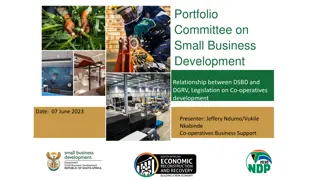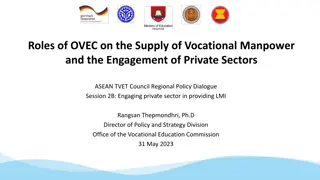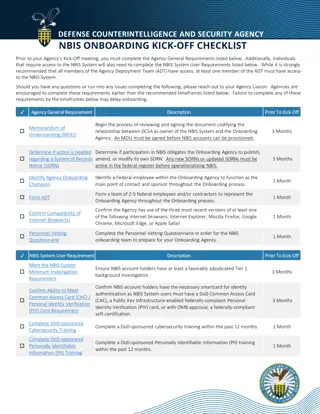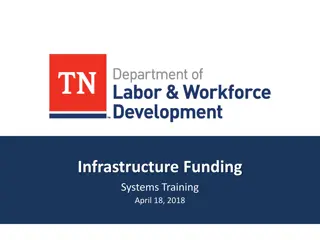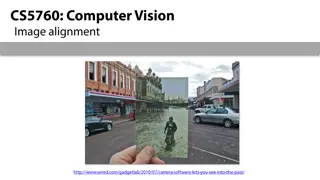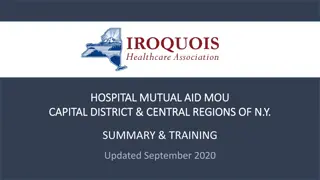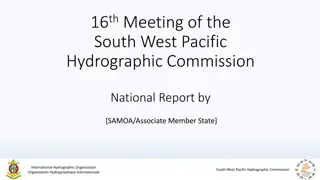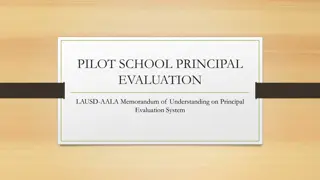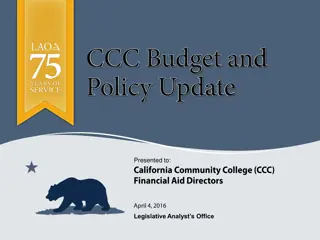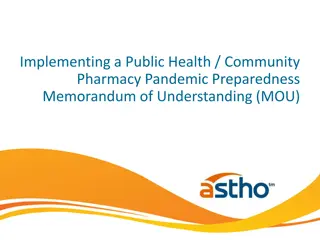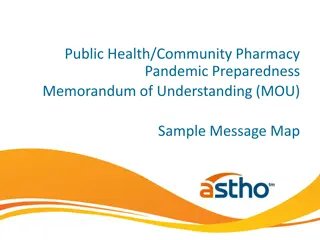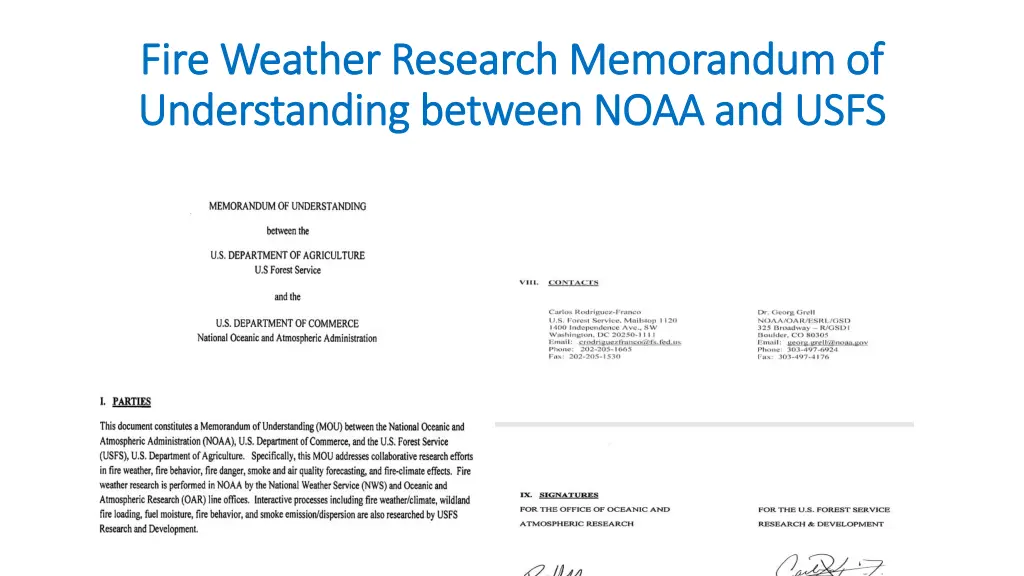
Understanding the MOU between NOAA and USFS for Fire Weather Research and Management
Explore the memorandum of understanding between NOAA and USFS regarding fire weather research, weather disasters related to wildfires, motivation documents, mandates, and the purpose of the MOU. Learn about their collaborative efforts, research partnerships, and focus areas to address fire potential, danger, behavior, and smoke products.
Download Presentation

Please find below an Image/Link to download the presentation.
The content on the website is provided AS IS for your information and personal use only. It may not be sold, licensed, or shared on other websites without obtaining consent from the author. If you encounter any issues during the download, it is possible that the publisher has removed the file from their server.
You are allowed to download the files provided on this website for personal or commercial use, subject to the condition that they are used lawfully. All files are the property of their respective owners.
The content on the website is provided AS IS for your information and personal use only. It may not be sold, licensed, or shared on other websites without obtaining consent from the author.
E N D
Presentation Transcript
Fire Weather Research Memorandum of Fire Weather Research Memorandum of Understanding between NOAA and USFS Understanding between NOAA and USFS
Weather Disasters Related to Wildfires: Weather Disasters Related to Wildfires: Billion Dollar Hits for Four Decades! Billion Dollar Hits for Four Decades!
Motivation Documents for USFS NOAA MOU Motivation Documents for USFS NOAA MOU Fire Weather Research: A Burning Agenda for NOAA . Report from Science Advisory Board, October 2008. NOAA supposed to focus on 10 high priority recommendations in these areas (46 recommendations): Fire weather and smoke modeling Research with and access to observational data Operational fire weather capabilities and services Establish a NOAA fire weather research focus and associated partners test bed Wildland Fire and Fuels Research and Development Strategic Plan: Meeting the Needs of the Present, Anticipating the Needs of the Future . US Department of Agriculture Forest Service, June 2006: Improve prevention and suppression Reduce hazardous fuels Restore fire-adapted ecosystems Promote community assistance
Mandates for USFS and NOAA Mandates for USFS and NOAA Secretary of Commerce shall have charge of the forecasting of weather, the issue of storm warnings, the display of weather and flood signals for the benefit of agriculture, commerce and navigation, the gauging and reporting of rivers Organic Act of 1890 15 USC 313 43 USC 1701 maintains that public lands be managed in a manner that will protect the quality of scenic, scientific, historical, ecological, environmental, air and atmospheric, water resource, and archeological values preserve and protect certain public lands in their natural condition provide for outdoor recreation and human occupancy and use
Purpose of MOU Purpose of MOU Provides a framework for implementing and expanding research partnerships focused on weather & climate and their effects on fire potential, fire danger, fire behavior, and fire smoke products Must connect weather elements such as numerical model output, data assimilation, surface and aerial-based observations, satellite data, and operational forecasts with sustainable and reliable land management and firefighting operations Identify collaborative efforts, funding sources and sponsorship that will ensure successful research and R2O
Scope of MOU Scope of MOU Identify improvements in analysis, assimilation and forecasts for wildfires Determine collaborative structures to verify coupled fire weather and fire/smoke models Identify technology framework to deliver improved forecast model output Formation of interagency working group focused on addressing all aspects of fire weather, fire behavior, fuel loading, fuel moisture, fire/smoke modeling Evaluation of earth-system modeling approach that includes land surface and atmosphere-biological feedback Development of projects that address fire potential and fire-climate interaction Determine joint agency field opportunities that support advancement of fire behavior and weather prediction at high resolution
Milestones Milestones Climate Change/Variability Focus Climate Change/Variability Focus Area Area Two Year Milestones 1. Identify precipitation shifts (amounts and timing) over different areas of the country, especially in the Southwest US. Five Year Milestones 1. Detailed examination of shifts in precipitation patterns and relationships to changing fire danger on a seasonal/monthly scale. 2. Investigation of the relationship between drought and fire with more realistic fuel data and vegetation response
Milestones Milestones Observations Focus Area Observations Focus Area Two Year Milestones 1. Measurement of atmospheric conditions near active fires with UAS. 2. Extension of NightFox project to include matching of satellite-derived indices with those that are remote sensed from aircraft or other means. Five Year Milestones 1. Planning and execution needed for all aircraft (including UAS) equipped with atmospheric sensors and for those sensors to be included in concise operational planning for support of all firefighters and incident command staff.
Milestones Milestones Forecast Models Focus Area Forecast Models Focus Area Two Year Milestones 1. Establishment of catalog of gridded products and data important to fire weather modelers, with identified formats and resolutions 2. Development of new smoke forecasting algorithms for Weather Forecast Offices, IMETs and GACC forecasters based on recent work in northern CA Five Year Milestones 1. Improvements in sub-seasonal versus seasonal forecasting 2. Integration of ensemble-based forecasting into firefighting operations and planning
Milestones Milestones Intelligent Aids Focus Area Intelligent Aids Focus Area Two Year Milestones 1. Assessment of where we are going with merging fire and weather data and see what adjustments we need to make with integration of real-time and ensemble-bases info 2. Improve the merging of airborne IR measurements of fire and those from satellite, especially with emergence of VIIRS and GOES-16/17 ABI data Five Year Milestones 1. Development or integration of technology allowing a localized network of observations and models forecasting the evolution of active fires using rapidly downloadable real-time fuel and weather information
Milestones Milestones Weather Info for DSS Focus Area Weather Info for DSS Focus Area Two Year Milestones 1. Establish a baseline for where we are in terms of providing meteorological data and predictive capability to firefighters 2. How do we improve support to firefighters after identifying shortfalls and new tools? 3. Develop plan to integrate realistic fuel data and terrain information into Red Flag Warnings. Five Year Milestones 1. Total fire prediction involving real-time fuels and vegetation, not using long-term averages that are unrealistic for many fire scenarios.
Milestones Milestones Validation & Verification Validation & Verification Focus Area Focus Area Two Year Milestones 1. Refine options for field experiment using resources from NOAA, land management agencies and academia Five Year Milestones 1. Use experimental data to answer questions about efficient use of UAS, how operators can adjust to large influx of data, special training, and what end user products can be developed which are of actual use to field managers and planners.
Opportunities to Meet Milestones Opportunities to Meet Milestones Do we have an opportunity to provide testing and R2O for work of Jim Bresch and John Horel (convective modeling)? What can we do to increase collaboration on ensembling and blending in NCEP work? How can we merge work on smoke and plume modeling (Baker, Kahn, Ahmadov, Peterson)? What work has been done lately with integration of Small UAS? Is NightFox still going on? What are the plans of the SERTC center in Colorado? We should use for Validation and Verification Focus Area What is the latest work of the Storm Prediction Center for Fire Weather? How is the R2O going with the HDWI? Are the potential projects involving WFOs and universities for COMET Partners? What is the latest with NCAR Fire Behavior model work (thanks, Jason)? Need to involve IMETs heavily What kinds of projects are USFS scientists working on with relevance to focus areas? (thanks Brian and Jay for taking lead) OAR has worked with NESDIS and NWS on a proposed fire weather testbed .more to follow but this is promising Next day long meeting (virtual): Planning for first week November 2021. Next virtual meeting: After July 5, 2021.

